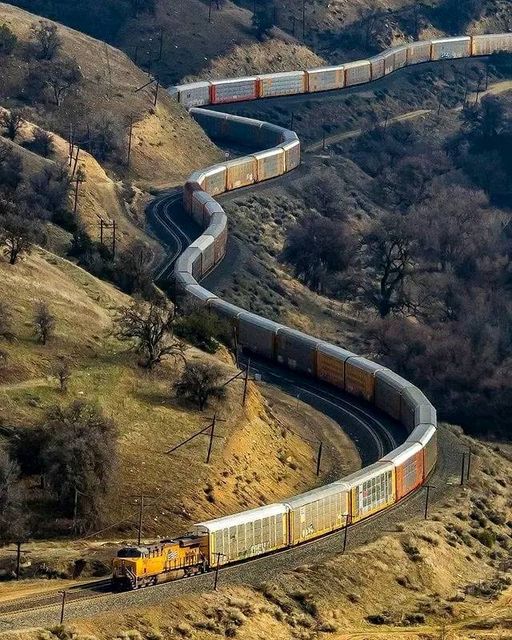by David Shedrack
Beginnings: 19th century
The original company, Union Pacific Rail Road (UPRR), was created and funded by the federal government by Pacific Railroad Acts of 1862 and 1864. The laws were passed as war measures to forge closer ties with California and Oregon, which otherwise took six months to reach. UPRR remained under partial federal control until the 1890s. Its management was noted for many feuds and high turnover. The UPRR main line started in Council Bluffs, Iowa and moved west to link up with the Central Pacific Railroad line, which was built eastward from Sacramento.
Construction on the UPRR main line was delayed until the American Civil War ended in 1865. Some 300 miles of main line track were built in 1865–66 over the flat prairies. The Rocky Mountains posed a much more dramatic challenge but the crews had learned to work at a much faster pace with 240 miles built in 1867 and 555 miles in 1868–69.[1] The two lines were joined in Utah on May 10, 1869, hence creating the first transcontinental railroad in North America. Interstate 80, built in the 1950s, paralleled the UPRR main line.
In 1870 the fare in coach from Omaha to San Francisco was $33.20 (sleeper cars cost extra). The train stopped for meals at lunch rooms along the way. Passenger traffic for the long trip was light at first—2,000 a month in the 1870s, growing to 10,000 a month in the 1880s.[2]
Wall Street speculator Jay Gould (1836–1892) took control of the UPRR in 1874, as well as the smaller Kansas Pacific Railway based in Kansas City. He merged the two into the Union Pacific Railway in 1880, giving the Union Pacific new markets in the wheat and ranching regions of Kansas and eastern Colorado. Branches were opened to mining districts in Montana, Idaho, and Utah and (until 1893) to farmlands in Oregon. Despite severe austerity measures the Union Pacific was unable to repay its old government loans. Most of the wheat farmers joined the People’s Party, a Populist movement in the 1890s and engaged in heated anti-railroad rhetoric. The Populists were soon voted out and had no lasting impact on the Union Pacific.
In the Panic of 1893 financial crisis the Union Pacific Railway, like 153 other American railroads, went bankrupt. The trains continued to operate but the bondholders lost their investment. In 1897, a new Union Pacific Railroad (UP) was formed and absorbed the Union Pacific Railway; this new railroad reverted to the original Union Pacific name of the original company but now pronounced “Railroad” and not “Rail Road”.[3] Empire builder E. H. Harriman (1848–1909) purchased the UP for a song. He upgraded its 3,000 miles of trackage, modernized its equipment and merged it with the Southern Pacific, which dominated California. The Supreme Court broke up the merger in 1910. From 1910 to 1980, there was little growth in the UP, which dominated the farming, ranching, mining and tourist trade in a region stretching from Omaha and Kansas City in the East, to Salt Lake City and Denver in the West.[4] Economically, the UP provided transcontinental service, as well as shipping out wheat and other crops, cattle, and mining products and bringing in consumer items and industrial goods from the East.
There was little expansion 1910–1980 but after that the UP system grew to over 32,000 miles of track with large lines like the Southern Pacific, the Missouri Pacific Railroad and the Missouri–Kansas–Texas Railroad becoming part of the UP system as well as smaller ones.
Business standards
Jan Richard Heier argues that, “America’s greatest technological achievement of the nineteenth century” was the transcontinental railroad. He adds that the political scandal over the disposition of millions of dollars in government bonds led to Congressional hearings that showed the weakness of accounting methods. The reporting of assets, liabilities, and capital followed standards of the day. The companies had to invent new methods for accounting for stock dividends and bond discounts.[23]
Congress distrusted the UP, and forced it to hire as the new president a distinguished member of the Adams family, Charles Francis Adams, Jr. in 1884. Adams had long promoted various reform ideas, but had little practical experience in management. As railroad president, he was successful in getting a good press for the UP, and set up libraries along the route to allow his employees to better themselves. He had poor results dealing with the Knights of Labor labor union. When the Knights of Labor refuse extra work in Wyoming in 1885, Adams hired Chinese workers. The result was the Rock Springs massacre, that killed scores of Chinese, and drove all the rest out of Wyoming.[24][page needed] He tried to build a complex network of alliances with other businesses, but they provided little help to the UP. He had great difficulty in making decisions, and in coordinating his subordinates. Adams was unable to stanch the worsening financial condition of the UP, and in 1890 Gould forced his resignation.





